Don't wanna be here? Send us removal request.
Text
U.S. Remote Patient Monitoring (RPM) Market is estimated to reach $15 billion opportunity by 2025 and increase at a CAGR of 25% between 2020-2025

The U.S. Remote Patient Monitoring (RPM) market has a massive, untapped growth opportunity of over $ 10 billion, according to Medi-Tech Insights' most recent analysis.
The U.S. Remote Patient Monitoring (RPM) market is expected to be a $15 billion opportunity by 2025. The U.S Remote Patient Monitoring (RPM) market set to witness 25% CAGR (2020-2025), driven by Chronic Disease Management, Post-acute Care, Home Health Care & Introduction of new CPT codes in RPM by CMS. In-depth analysis of key growth levers, pricing intelligence, the competitive landscape, segment analysis, product/offering mapping, and untapped growth pockets are all included in the study.
The healthcare field is one that is expanding quickly and marked by ongoing technological and service advancements Remote patient monitoring is a significant advancement in this area that offers many benefits in an ageing world population with rising health complications. The technology has developed to the extent that patients can be monitored not only inside hospitals rooms but also at home with the use of modern communication and sensor technologies.
Technological advancements in remote patient monitoring devices allows monitoring of multiple vital sign parameters such as blood pressure, heart rate, respiration rate, electrocardiogram reading, temperature, blood glucose levels, among others. The technology is being used to keep an eye on a wide range of individuals, including elderly people, accident victims, premature children, and patients with long-term illnesses.
Influencing Factors: U.S. Remote Patient Monitoring (RPM) Market
Drivers
Introduction of new CPT reimbursement codes by the CMS in 2019 (CPT 99453, CPT 99454 and CPT 99457) and 2020 (CPT 99458) to broaden the adoption of RPM services
Rising burden of chronic diseases and pressure to reduce healthcare costs
Growing recognition of RPM as a tool to proactively monitor and improve patient engagement, and reduce ED visits, readmissions, and lengths of stay in hospital—all of which help improve patient outcomes and contain costs
Presence of 200+ small and mid-size companies in RPM space leading to competitive environment for growth and innovation
Favourable investment landscape for RPM & Telehealth
Barriers/Challenges: Remote Patient Monitoring (RPM) Market
Continuous Data Monitoring - Cumbersome to monitor all the data 24*7 by the physicians/clinical staff & frequent false alerts
Patient Readiness & Data Privacy Concerns - Most chronically ill individuals are older, generally less tech-savvy and often warier that technology will intrude on their personal life
Data Integration – Integrating third-party RPM data with the EHR
Covid-19 Lends a Positive Spin to the U.S. Remote Patient Monitoring (RPM) Market
Covid-19 had positive impact on the U.S. remote patient monitoring (RPM) market as value of RPM services became even more apparent. The next phase of growth is expected to be driven by increased adoption and usage of remote patient monitoring services in the ongoing pandemic, need to reduce patient costs and improve outcomes for patients with chronic conditions. Patient demand and financial incentives for providers and health systems are driving demand for post-acute care in areas like cardiology, orthopedics amongst others.
Explore Premium Report on U.S. Remote Patient Monitoring (RPM) Market @ https://www.prweb.com/releases/u_s_remote_patient_monitoring_rpm_to_be_a_15_billion_opportunity_by_2025_driven_by_chronic_disease_management_post_acute_care_introduction_of_new_cpt_codes/prweb18015114.htm
Providers are Biggest Users but Other High Growth Segments Emerging
While providers will continue to produce the largest segment, other segments including health plans/payors, employers, home health agencies, and clinical trials are predicted to expand at a CAGR of 35-45% over the next 5 years.
U.S. Remote Patient Monitoring (RPM) Market – A Highly Fragmented Market
The RPM market is highly fragmented with over 200 companies vying to grab a share of this nascent market and it is critical for RPM companies to deploy well-researched pricing and go-to-market strategies. Companies from the PERS and Telehealth markets are also interested in entering the market, as seen by Teladoc's recent acquisition of Livongo.
Key Growth Levers for Remote Patient Monitoring (RPM) Companies Include:
Offering solutions that are comprehensive, integrated and tailored to chronic disease areas like diabetes, COPD, hypertension
Incorporation of AI/ML into RPM solutions to increase patient engagement & compliance
Going beyond capturing data and helping physicians to manage patient populations to improve outcomes and reduce costs
Partnerships with third-parties including technology companies, device manufacturers, patient care companies to provide holistic care pathway
Strategic M&A to acquire wider coverage of geographies, disease areas and to gain scale and financial muscle
Business Models of U.S. Remote Patient Monitoring (RPM) Market
Currently, multiple business models are being deployed but Subscription Based Model is the most widely used business model in the remote patient monitoring (RPM) market. According to this model, remote patient monitoring companies provide providers access to RPM platforms and devices, which are then shared with patients for remote monitoring of their physiological parameters and vital signs.
Competitive Landscape Analysis of U.S. Remote Patient Monitoring (RPM) Market
In terms of competitive landscape, the U.S. remote patient monitoring (RPM) market is marked by presence of both established players and several small players. Some of the prominent players operating in the market U.S. remote patient monitoring (RPM) market include Vivify Health, Health Recovery Solutions, Teladoc-Livongo, Amwell, AMC Health, Careclix, Ontrak, Accuhealth, iHealth Labs and many others.
Innovative companies are differentiating from their competitors by fine-tuning their business models, refining their product & service offerings and tailoring pricing strategies based on type of customer segment, geographic coverage, population health metrics & continuum of care offered.
Today, there is a unique window of opportunity to tap into this high-growth RPM market by developing the right strategies and leveraging industry acumens.
For More Comprehensive Insights, Contact Us @ https://meditechinsights.com/contact-us/
About Medi-Tech Insights
Medi-Tech Insights is a healthcare-focused business research & insights firm. Our clients include Fortune 500 companies, blue-chip investors & hyper-growth start-ups. We have successfully completed 100+ projects in Digital Health, Healthcare IT, Medical Technology, Medical Devices & Pharma Services.
Contact:
Ruta Halde
Associate, Medi-Tech Insights
+32 498 86 80 79
0 notes
Text
Global Digital Health Market is anticipated to grow at a CAGR of 28% to reach $ 96 billion by 2025 | Medi-Tech Insights
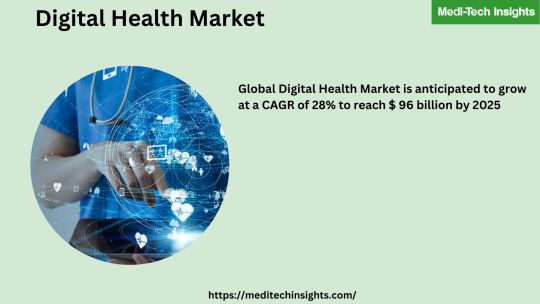
Global Digital Health Market Opportunity is driven by Virtual Care, Remote Patient Monitoring, Digital Therapeutics and AI. Global Digital Health Market is expected to grow at a CAGR of +36% to reach ~$12 billion by 2025.
The Global Digital Health Market is anticipated to reach $96 billion by 2025, driven by factors such as Covid-19, favorable reimbursement (CMS codes in the US, Digital Act in Germany, etc.), and an ageing population with chronic diseases. Total corporate funding for digital health market, which includes debt, public market financing, and venture capital, reached $21.6 billion in 2020, an increase of 103% from $10.6 billion in 2019. The way healthcare is provided is rapidly changing because to a unique confluence of emerging technology including wearables, remote vitals monitoring, and artificial intelligence.
Key segments within Digital Health Market include:
Virtual Care including Teleconsultations, Behavioral health amongst others
Remote Monitoring, Digital Diagnostics and Chronic Disease Management
Digital Therapeutics
AI enabled Drug Discovery and Development, Clinical Trials
Other digital care delivery models including digital pharmacies, insurances & clinical decision systems
Companies need to tackle a number of challenges that have historically slowed down the adoption of digital technologies in healthcare in order to maintain the current growth rate. Some of those challenges are long regulatory pathway, complex & multi-layered reimbursement systems, lack of interoperability, inertia of health systems and physicians and privacy concerns amongst patients.
According to the study, the pandemic has caused significant changes in the adoption of digital tools in a number of areas, and patients, physicians, and health systems now have much more positive outlooks than they had 18 to 20 months ago. Having used digital tools like virtual consultations, remote patient monitoring for chronic diseases, virtual monitoring of certain end-points for clinical trials, the key decision-makers are ready to allocate significant budgets to enable the digital transformation.
Explore Premium Report on Digital Health Market @ https://www.einnews.com/pr_news/545391983/global-digital-health-market-to-reach-96-billion-by-2025-forecasted-to-grow-at-28-cagr-as-per-medi-tech-insights
In the report, we analyze over 200 companies in this sector and assess market size, growth across United States, EU, Middle East, APAC and Latin America.
Virtual Care including Teleconsultations, Behavioral Health & Innovative Delivery Models
Virtual Care Includes virtual primary and specialist consultations, remote behavior health business models and innovative care delivery models. Key companies includes Amwell, Teladoc, Dr on Demand, Doctolib, Tytocare and others.
Remote Monitoring, Digital Diagnostics and Chronic Disease Management
Growing at 25% CAGR includes chronic care management and post-acute care with companies like Medtronic, Vivify, Withings, HRS, Current Health, Zio, iRhythm and over 100 others leading the way care is given in out-of-hospital settings to improve outcomes and reduce costs.
Digital Therapeutics Market
We believe the Prescription Digital Therapeutics (PDT) market is growing +36% year over year and may reach ~$12 billion by 2025. Substance abuse disorder, major depression, insomnia, migraine, pain management, and dieting are areas of interest within PDT. Key companies include Pear Therapeutics, Akili, Gaia, Click Therapeutics and also large Pharma players like Novartis, AstraZeneca, Teva are making headway into this fast-growing segment of digital health.
AI enabled Drug Discovery and Development, Clinical Trials
It typically takes $1-3 billion in R&D costs to develop a new drug and timelines can be as long as 10+ years. The drug discovery and development process are one of the most logical areas for AI-enabled transformation. Companies that are transforming drug discovery and development for pharma include AI-ML enabled platforms of Atomwise, Benevolent AI, Exscientia, Schrödinger and many other companies.
Other Digital Care Delivery, Insurance Models
The digital health market segment includes a variety of subsectors, including improving clinical decision support (Tabula Rasa, Microsoft, IBM, Philips), digital pharmacies (Amazon's PillPack, GoodRx, TabulaRasa), digital insurances (eHealth, Health Equity), improving/automating revenue cycle (R1 RCM, Phreesia, nThrive), and other key areas.
Innovative companies are differentiating from their competitors by fine-tuning their business models, refining their product & service offerings and tailoring pricing strategies based on type of customer segment, geographic coverage, population health metrics & continuum of care offered. Today, there is a unique window of opportunity to tap into this high-growth market by developing the right strategies and leveraging industry acumens.
For More Detailed Insights, Contact Us @ https://meditechinsights.com/contact-us/
About Medi-Tech Insights
Medi-Tech Insights is a healthcare-focused business research & insights firm. Our clients include Fortune 500 companies, blue-chip investors & hyper-growth start-ups. We have completed 100+ projects in Digital Health, Healthcare IT, Medical Technology, Medical Devices & Pharma Services.
Contact:
Ruta Halde
Associate, Medi-Tech Insights
+32 498 86 80 79
0 notes
Text
Global Digital Pathology Market is expected to grow at a CAGR of 11% to reach $ 1.54 billion by 2030 | Medi-Tech Insights
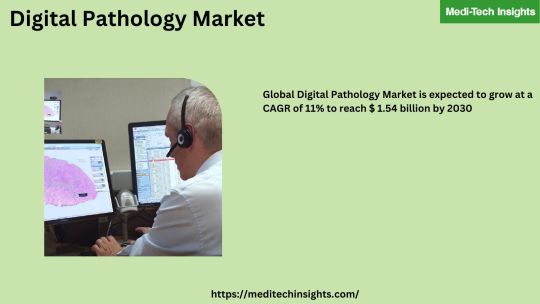
Key Research Findings in the Digital Pathology Market
The Global Digital Pathology Market is estimated to reach $ 1.54 billion by 2030 growing with a CAGR of 11% from 2020-2030. In the field of pathology, digitalization and automation have the potential to significantly improve outcomes for patients, physicians, pathologists, and labs/hospitals.
Consider the following startling facts:
97% of departments don’t have enough histopathologists for the workload, and that workload is rising
19 hours/day are spent on physical slide logistics (reported in laboratory with 220 cases/day)
An estimated 98% of pathologists are relying on manual workflows and microscopes for primary diagnosis, which can cause delays and inefficiencies, and create barriers for remote collaboration
Digital Pathology has been around for many years but the current Covid-19 pandemic has highlighted the advantages that digital pathology may provide for laboratories, hospitals, clinicians, and pathologists.
The benefits are multi-fold:
Improves efficiency workflow
Faster turnaround time leading to benefits for labs, patients & clinicians
Pathologists can focus their time on reading of images
Possibility to tap into wider expertise to improve accuracy of diagnosis
Improves work satisfaction for pathologists
With AI/ML, can aid in improving accuracy of diagnosis
These advantages, along with a favorable regulatory environment and reimbursement, are anticipated to fuel the digital pathology market expansion.
Explore Premium Report on Digital Pathology Market @ https://www.prweb.com/releases/digital_pathology_market_set_to_grow_at_11_cagr_to_reach_1_54_billion_by_2030_companies_deploying_innovative_data_driven_alogithms_business_models_to_grow_market/prweb18095510.htm
Scanners, which are used to digitally scan the samples, dominate the digital pathology market at the moment. The digital pathology market is anticipated to expand more quickly in the coming years as a result of the usage of AI/ML technologies for image recognition, analysis, and diagnosis aid.
The scanner segment is dominated by companies like Philips, Hamamatsu, and Leica, while a number of well-funded start-ups are making headway in the software and AI-ML platforms. Among other well-known companies are Paige, Path AI, Ibex, Aiforia, Proscia, and Reveal Biosciences/CellCarta.
In a current article, Memorial Sloan Kettering Cancer Center highlighted the benefits of digital workflow in pathology and how it helped them immensely during the pandemic - “We were motivated by a real concern for our doctors,” Dr. Matthew Hanna, Director of Pathology Informatics says. “Finding a way for them to work at home has eliminated a huge burden during the pandemic.”
Scanners, software, AI/ML applications, and the key emerging players & technologies in each of the segments are all thoroughly examined in the study.
Companies that aim to capture greater share in this high-growth market need to focus on:
Understanding key customer pain points and unmet needs with current scanners, software
Keeping abreast of latest developments in AI/ML technologies that aim to revolutionize the way pathology diagnosis is done
Be aware of the challenges including regulatory pathways, reimbursement and develop strategies to overcome these challenges
As a result of their extensive experience working in the field of digital pathology market, Medi-Tech Insights is well-versed in its intricacies and nuances and has successfully assisted many established players, start-ups to grow revenues by 10x.
For More Detailed Insights, Contact Us @ https://meditechinsights.com/contact-us/
About Medi-Tech Insights
Medi-Tech Insights is a healthcare-focused business research & insights firm. Our clients include Fortune 500 companies, blue-chip investors & hyper-growth start-ups. We have completed 100+ projects in Digital Health, Healthcare IT, Medical Technology, Medical Devices & Pharma Services.
Contact:
Ruta Halde
Associate, Medi-Tech Insights
+32 498 86 80 79
0 notes
Text
Global Digital Therapeutics Market is expected to be valued at $ 2.2 billion and is anticipated to grow rapidly
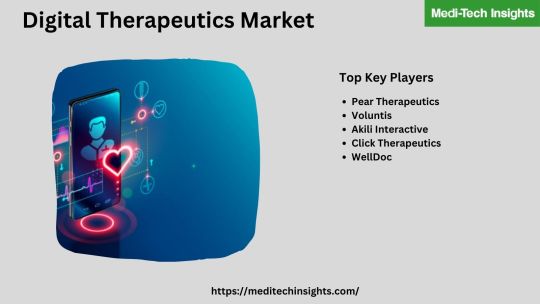
A new class of therapeutics known as "digital therapeutics" (DTx) has been made possible by the evolution and widespread adoption of technology, specifically in the areas of artificial intelligence, deep learning, and health monitoring using wearables, changing medical protocols, the need to reduce costs, and these factors are all influencing to the transformation of healthcare.
The global digital therapeutics market pegged at $ 2.2 billion (2020) is set to gain momentum. The next phase of expansion is probably going to be fueled by expanding pharma-digital therapeutic alliances, increasing focus of digital therapeutics companies on mental health, psychiatric conditions, and cognitive impairments, gradually improving reimbursement situations, a favorable funding environment, and a strong pipeline of digital therapeutics products.
Digital therapeutics are products (software programs) that deliver evidence-based therapeutic interventions to patients to prevent, manage, or treat a medical disorder or disease (Source: Digital Therapeutic Alliance). To optimize patient care and health outcomes, they can be used alone or in combination with other therapies, medications, and medical devices.
Digital therapeutics is poised to revolutionize the healthcare industry. It finds usage across a range application such as Diabetes, Chronic Respiratory Disorders, Musculoskeletal Disorders, Smoking Cessation, Cardiovascular Diseases, CNS Disorders, Obesity and Others. It offers immense value for multiple stakeholders. A growing number of key stakeholders, including the FDA, HCPs, Payers, and Patients, are now accepting digital therapeutics as a form of therapy.
The following benefits for the stakeholders across the healthcare spectrum testifies the potential for digital therapeutics.
Patients: On-demand and easy access to clinically-validated therapies, treatment and care. Personalized and flexible care for many chronic conditions
Providers: Digital therapeutics can be used as a monotherapy or in concert with other therapies to optimize patient care and outcomes. Physicians/caregivers can support patients remotely and monitor their response to treatment without an office visit thereby leading to a lower cost of care. It also provides them access to novel treatment options
Payers: Improved clinical & health outcomes, disease prevention and reduction in overall medical costs
Pharmaceutical Companies: Pharma companies could benefit from data collected by digital therapeutics companies about patient and their condition. Through digital therapeutics, pharmaceutical companies can improve the efficacy of their existing therapies. digital therapeutics can also be used in clinical research to speed the drug approval process. Example - Bayer, Otsuka, and Sanofi’s investments into digital therapeutic start-ups
Explore Premium Report on Digital Therapeutics Market @ https://www.medgadget.com/2021/08/digital-therapeutics-market-size-at-2-2bn-poised-to-revolutionize-the-pharma-digital-health-industry-innovative-business-models-favourable-reimbursement-robust-product-pipelines-set-to-impact-be.html
The digital therapeutics market has also attracted attention of several investors and they too are aligned on the value of digital therapeutics.
Consider the following facts that has made digital therapeutics so fundable.
Data Collection Capabilities: Digital therapeutics can collect an huge amount of patient health data which can be used for personalized treatment of patients, enable data-driven care for providers and improve health outcomes
Effective Tool for Chronic Conditions: Chronic conditions continue to increase in prevalence and has debilitating effect on the healthcare system. Digital therapeutics has emerged as an effective tool for chronic disease management
Digital therapeutics Supported by Clinical Evidence: Since digital therapeutics products are backed by clinical data, there is clinical evidence of it being effective
Cater to Unmet Needs: Digital therapeutics has showcased potential to address many chronic conditions which have unmet needs such as treatment-resistant depression and opioid addiction
Strong Positive Outlook: The estimated market potential of digital therapeutics outweighs the hurdles
Geographic Snapshot: Digital Therapeutics Market
Comprehensive regional assessment of the global digital therapeutics market covering U.S., Europe (Germany, Italy, France, Spain, UK, and Rest of Europe), Asia-Pacific (India, China, Japan, Australia, New Zealand, Singapore and Rest of Asia-Pacific) and Rest of the World (Latin America, Middle-East & Africa) suggests that U.S. is likely to continue its dominance in the next 10 years.
The U.S. digital therapeutics market is expected to rise due to factors like an increase in the incidence of chronic diseases, favorable government policies and grants, increased public awareness about the importance of digital therapeutics, and a well-developed healthcare infrastructure. Facilitation of digital therapeutics led by Pharmacy Benefit Managers (PBMs) in the U.S. is also expected to fuel its adoption.
For instance,
In Dec 2019, Express Scripts announced that digital therapeutics solutions would be added to its digital health "formulary”.
In June 2019, CVS Caremark unveiled a platform that enables payers to formalize and streamline the process for digital therapeutics reimbursement and distribution.
Psychiatry Remains #1 Application in Clinical Trials of Digital Therapeutics
A review of trends of digital therapeutics clinical trials over the past ten years suggests that with respect to therapeutic areas (TA) under investigation, the highest percentage of trials were conducted for psychiatry indication followed by cardiovascular, addiction, endocrinology, neurology, and respiratory indications. Strong pipeline of digital therapeutics products across diverse application areas - neuroscience indications, cardiovascular diseases, gastrointestinal diseases, chronic kidney disease (CKD), among others is likely to provide impetus to the global digital therapeutics market.
Various strategies Adopted by Players to Establish Their Foothold in Digital Therapeutics Market
Players operating in the digital therapeutics market are implementing various strategies to expand their foothold into the market.
For instance,
In Jan, 2021, etectRx (Digital Health Company) entered into an agreement with Pear Therapeutics to develop up to two product candidates in the Central Nervous System (CNS) space combining Prescription Digital Therapeutics (PDTs) and adherence sensors. The collaboration explores the use of digital pill solutions with PDTs.
Through their work in Digital Therapeutics over the years, Medi-Tech Insights understands the intricacies & nuances of Digital Therapeutics and has successfully assisted many established players, start-ups to grow revenues by 10x.
Business Models and Competitive Landscape Analysis of Digital Therapeutics Market
Citing the lucrative prospects of the market, several new players have entered the digital therapeutics market. Players such as Hinge Health, Thirty Madison, Akili Interactive and others have witnessed significant funding’s and are expected to carve a niche for themselves.
There are now many different business models being used, but considering the early stages of digital therapeutics, it will probably take a few years to determine the most suitable one for scaling and commercializing a digital therapeutic successfully.
In terms of competitive landscape, the digital therapeutics market is marked by presence of both established players and several small players. Some of the prominent players operating in this market include Pear Therapeutics, Voluntis, Akili Interactive, Click Therapeutics, WellDoc, among others.
For More Detailed Insights, Contact Us @ https://meditechinsights.com/contact-us/
About Medi-Tech Insights
Medi-Tech Insights is a healthcare-focused business research & insights firm. Our clients include Fortune 500 companies, blue-chip investors & hyper-growth start-ups. We have completed 100+ projects in Digital Health, Healthcare IT, Medical Technology, Medical Devices & Pharma Services.
Contact:
Ruta Halde
Associate, Medi-Tech Insights
+32 498 86 80 79
0 notes
Text
Global Diabetes Devices Market is expected to grow at a CAGR of ~6% by 2026: Improving Quality of Care for Diabetes Patients
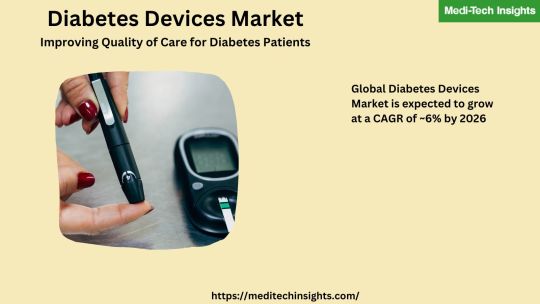
Diabetes devices are devices that measure the blood glucose level in the body at regular intervals. Many types of devices fall under the category of diabetes care such as blood glucose monitoring devices and insulin delivery devices.
The Diabetes Devices Market is expected to grow at a rate of ~6% by 2026. Some of the main factors propelling the global diabetes devices market include the rising prevalence of diabetes, rising health consciousness and awareness regarding diabetes, rising obesity and unhealthy eating habits among the population, technological advancements in diabetes monitoring devices, and rising adoption of insulin delivery devices.
A Slowdown in the Demand for Diabetes Devices Points to Looming Recession
The economic recession is anticipated to have a mixed effect on medical device companies. Consumer spending on healthcare devices may be impacted by the ongoing economic downturn in the US and Europe. Sales have dipped slightly for blood glucose monitors and even test strips. Tandem Diabetes Care is the first organization in the space to directly attribute a slowdown in sales to recession fear.
The Growing Adoption of Continuous Glucose Monitoring (CGM) Devices Drives the Global Diabetes Devices Market
A CGM device is a wearable technology designed to monitor glucose levels without finger pricks. CGM may be useful for people who need to monitor their sugar levels more frequently to see trends and patterns. Technological development in CGMs is increasing their adoption in the diabetes devices market.
Increasing Emphasis on Developing New Insulin Products
The need for diabetic devices is being driven by an increase in the demand for advanced insulin delivery systems, which is being supported by a high adoption of recently launched innovative smart devices and portable products.
For instance,
in March 2022, Novo Nordisk announced the launch of its smart insulin pens in the UK, providing diabetes patients within the NHS access to devices that can monitor and record dosing information.
Explore Premium Report on Diabetes Devices Market @ https://meditechinsights.com/diabetes-devices-market/
Potential of Digitization in Diabetes Care Using Sensors, Wearables, and Mobile Devices Boosts the Diabetes Devices Market
The rapid advances in the wearable device and remote sensor market are driven predominantly by the miniaturization of sensors & circuitry and the improvements in functionality and processing power of mobile devices. Numerous digital platforms have emerged, including DayTwo, Viome, and Glooko, among others, that are expected to boost the expansion of digitization in the field of diabetes care. These tools and mobile apps have been developed to close the loop between blood glucose tracking and insulin delivery.
Covid-19 Impact on Diabetes Devices Market
The need for diabetes devices increased during the COVID-19 pandemic as a preventative approach to control glucose levels and complications in patients with diabetes mellitus. Diabetic patients are more likely to have serious complications from COVID-19, thus CGM becomes very important for these patients.
Key Constraints/ Challenges: Diabetes Devices Market
Some of the major factors that are projected to hamper the growth of the diabetes devices market in the coming years include the high cost of CGM devices and reimbursement issues in developing countries.
North America Expected to Continue to Hold a Major Share in the Diabetes Devices Market
From a geographical perspective, North America holds a major market share of the diabetes devices market. This can be mostly attributed to the rising prevalence of diabetes, increasing acceptance of technologically advanced products, rising awareness regarding diabetes self-management solutions, and unhealthy food habits in the region.
Organic and Inorganic Growth Strategies Adopted by Players to Establish Their Foothold in the Diabetes Devices Market
Players operating in the diabetes devices market are accepting organic and inorganic growth strategies such as collaborations, acquisitions, and new product launches to garner market share.
For instance,
In August 2022, Insulet Corporation announced that they have received clearance from the U.S. FDA for its Omnipod® 5 Automated Insulin Delivery System (Omnipod 5) for individuals aged two years and older with type 1 diabetes (T1D)
Competitive Landscape Analysis of Diabetes Devices Market
Some of the key players operating in the diabetes devices market include Medtronic Plc, Abbott Laboratories, Dexcom, Insulet Corporation, and Ypsomed, among others.
For More Detailed Insights, Contact Us @ https://meditechinsights.com/contact-us/
About Medi-Tech Insights
Medi-Tech Insights is a healthcare-focused business research & insights firm. Our clients include Fortune 500 companies, blue-chip investors & hyper-growth start-ups. We have completed 100+ projects in Digital Health, Healthcare IT, Medical Technology, Medical Devices & Pharma Services.
Contact:
Ruta Halde
Associate, Medi-Tech Insights
+32 498 86 80 79
0 notes
Text
Global Intraocular Lens (IOLs) Market was valued at US$ 3.9 billion in 2021 and is likely to grow at a CAGR of ~5-6% by 2026
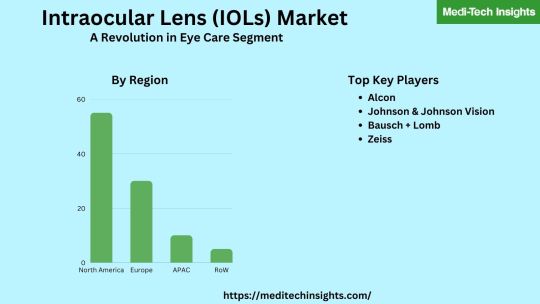
Intraocular lenses (IOLs) are long-lasting artificial lenses that can replace the eye's natural lens to restore both near distant vision. They are often made of silicone, acrylic, or other plastic components.
The Global Intraocular Lens (IOLs) Market was valued at US$ 3.9 billion in 2021 and is set to witness a growth rate of ~5-6% in the next 5 years. Some of the main factors driving the global IOLs market are the increase in cataract procedures due to an ageing population, the switch from monofocal IOLs to premium IOLs/advanced technology IOLs, the steady growth of monofocal IOLs in line with the procedural market, and favorable reimbursement scenarios in certain key markets.
However, some of the key elements that are expected to hamper market expansion are comparatively higher pricing and limited/partial coverage of premium/advanced technology IOLs.
Intraocular Lens (IOLs) Market Likely to Stay Largely Resilient Through Recession, Though the Value Mix is Expected to be Adversely Impacted
The Russia-Ukraine war has amplified the impact of COVID-19 and the global economic slowdown, which might result in extended periods of limited growth and high inflation. The situation is likely to lead to supply-chain disruptions and the risk of stagflation which might further curtail global economic growth.
Due to the impending recession, patients are anticipated to delay elective surgical procedures including cataract surgeries until the future of the broader economy looks more promising. In key markets such as the U.S., cataract surgeries involving monofocal IOLs are generally fully covered by medical insurance providers or government reimbursement programs whereas implantation of premium or advanced technology IOLs may only be partially covered, with the individual paying out-of-pocket for the non-covered-component. Considering the present economic and financial conditions, patients are expected to be less willing to incur the costs of these private pays or discretionary procedures and may choose to forgo such procedures or products and might consider trading down to more affordable options.
Furthermore, in the U.S., the 2023 Medicare Physician Fee Schedule final rule released by the Centers for Medicare & Medicaid Services (CMS) confirms a ~4.5% cut to surgeons and anesthesiologists, harming patient access to needed surgical care. Proposed reimbursement cuts are likely to adversely impact millions of beneficiaries who depend on Medicare to access sight-saving and sight-restoring procedures. However, healthcare insulation in key markets such as the U.S is likely to offset the anticipated adverse impact of the recession as most Americans now have health insurance. Payors are also expected to continue to inject capital into the healthcare economy.
Explore Premium Report on Intraocular Lens (IOLs) Market @ https://meditechinsights.com/intraocular-lens-market/
Under-penetrated Premium/Advanced Technology IOLs (AT-IOLs) Offers Ample Growth Opportunities in Intraocular Lens (IOLs) Market
The intraocular lens market is shifting from monofocal IOLs to premium IOLs/advanced technology IOLs. There lies a huge untapped potential market in the premium IOLs/advanced technology IOLs segment as current penetration stands at 7% outside the U.S. and 14% in the U.S. The comparatively higher pricing of premium IOLs/advanced technology IOLs is anticipated to drive the IOLs market value in the coming years.
Technological Advancements in Intraocular Lens (IOLs) is Driving the Growth of Global Intraocular Lens (IOLs) Market
Technological developments are expected to boost the intraocular lens (IOLs) market.
For instance,
In September 2022, Alcon introduced Clareon Toric IOL at the American Academy of Ophthalmology (AAO) 2022 annual meeting in Chicago, U.S., and completed the Clareon Collection. Clareon Toric is a glistening-free toric intraocular lens with exceptional clarity and unrivaled stability. It was rolled out across select practices in the U.S.
“Approximately 2.2 billion people globally suffer from impaired vision, and nearly 20% (200 million) people worldwide suffer vision impairment or blindness caused by cataract or uncorrected refractive error. There is a pressing need to increase manufacturing operations related to IOLs in order to cater to growing eye health needs.” - Operations Director, Leading IOL Manufacturer, U.S.
Organic and Inorganic Growth Strategies Adopted by Players to Establish Their Foothold in Intraocular Lens (IOLs) Market
The players operating in the IOLs market accepted both organic and inorganic growth strategies such as new product launches, expansion, investments, acquisitions, partnerships to gather market share.
For instance,
In September 2022, Johnson & Johnson Vision announced the availability of presbyopia-correcting intraocular lens (PC-IOL) powered by InteliLight technology, TECNIS Symfony OptiBlue IOL. The extended-depth-of-focus (EDOF) lens expands presbyopia correction to more patients and joins TECNIS Synergy IOL, a high-performance hybrid lens designed for spectacle independence, in the InteliLight portfolio
The outlook for the intraocular lens market looks promising due to the ageing population and increasing incidences of cataract, technical developments in IOLs, improved access to care, continuous investments by IOL manufacturers worldwide in promotion and education, a growing number of eye care professionals and dedicated eye hospitals, improving technology access and better patient awareness, and increasing government initiatives and awareness initiatives to control and treat blindness.
Competitive Landscape Analysis of Intraocular Lens (IOLs) Market
The global intraocular lens (IOLs) market is marked by the presence of prominent players such as Alcon, Johnson & Johnson Vision, Bausch + Lomb, and Zeiss. Other players operating in the market are HOYA Surgical Optics, BVI (Subsidiary - PhysIOL), Rayner Intraocular Lenses, SAV-IOL, SIFI S.p.A, Ophtec, STAAR Surgical Company, among others.
For More Detailed Insights, Contact Us @ https://meditechinsights.com/contact-us/
About Medi-Tech Insights
Medi-Tech Insights is a healthcare-focused business research & insights firm. Our clients include Fortune 500 companies, blue-chip investors & hyper-growth start-ups. We have completed 100+ projects in Digital Health, Healthcare IT, Medical Technology, Medical Devices & Pharma Services.
Contact:
Ruta Halde
Associate, Medi-Tech Insights
+32 498 86 80 79
0 notes
Text
Global Orthobiologics Market valued at $5.4 billion in 2021 and is anticipated to grow at a CAGR of 7% by 2026
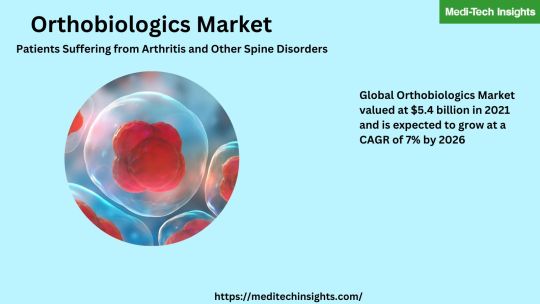
Orthobiologics uses biomaterials and cell-based therapies to heal musculoskeletal injuries quickly and support tissue healing and restoration through their regenerative potential. These products are derived from components that are naturally present in the body and interact dynamically with the musculoskeletal system to facilitate the healing of bone, cartilage, ligament, and diseased or injured meniscus & tendons.
The Global Orthobiologics Market valued at $5.4 billion (2021) is set to witness a growth rate of 7% in the next 5 years. Increasing geriatric and obese populations globally, an increase in the number of people suffering arthritis and other spine-related disorders, an increase in patient preference for minimally invasive procedures, and mechanical advancements in biomaterials are some of the main reasons propelling the global orthobiologics market.
Technological advancements in Orthobiologics Market to fuel its Global Market demand
The development of effective products with enhanced patient healing capacities and expanded applications, among other things, has been made possible by continuous advancements in orthobiologics. As a result, key companies are constantly focusing on investing in research activities for the development of new products and increasing their geographic reach to strengthen their positions in the orthobiologics market. Such advances tend to provide manufacturers a competitive edge.
Below is a list of a few technological developments:
In June 2022, Istos Biologics launched the Influx Fibrant line of 100% cortical allograft products featuring a patented technology from TheraCell and designed to advance patient healing
In March 2022, SeaSpine launched new orthobiologic products- NorthStar cervical facet fusion and Flash navigation lumbar facet fusion, with an aim to streamline reproducible procedural workflow while maximizing the area for fusion
In September 2020, Cerapedics received approval for its i-FACTOR+ Matrix bone graft from Health Canada. This next-generation bone graft is based on P15 osteogenic cell-binding peptide that supports bone growth through cell attraction, attachment, and activation
Explore Premium Report on Orthobiologics Market @ https://meditechinsights.com/orthobiologics-market/
Key Growth Strategies Adopted by Leading Market Players in Orthobiologics Market
Leading Market players operating in the orthobiologics market have accepted acquisition and partnership as key growth strategy to increase their product offerings, improve their geographic presence & distribution capabilities, and to co-develop advanced products.
Some of these developments are listed below -
In August 2022, Orthofix Medical Inc. entered in a strategic partnership with CGBio, a synthetic bone grafts developer, to co-develop and commercialize Novosis recombinant human bone morphogenetic protein-2 (rhBMP-2) bone growth materials and other tissue regenerative solutions for the Canadian and US markets
In July 2021, Celularity Inc. and Arthrex, Inc. entered into a supply and distribution agreement for the distribution and commercialization of multiple products including placental-derived biomaterial products from Celularity for orthopaedics and sport medicine in the US
In March 2021, SeaSpine Holdings Corporation entered in an agreement to acquire 7D Surgical, Inc., a Canada-based medical device company. This acquisition was aimed at combining spinal implant and orthobiologics portfolios to advance spine surgery
Irrespective of the challenges such as unfavorable reimbursement scenario and pricing pressure on market players, the global orthobiologics market is expanding and is anticipated to gain further momentum in the coming years due to a strong emphasis on spinal fusion segment, focus on demineralized bone putties with excipients, growing usage of viscosupplements, and innovations addressing the entire procedure, among others.
For instance, during the forecast period, advances in hyaluronic acid-based therapies, rising prevalence of lifestyle-induced disorders, high efficacy in delaying total knee replacement procedures, and growing preference for non-surgical treatments for osteoarthritis are expected to drive the viscosupplements segment. Furthermore, conventional techniques such as autograft and allograft are difficult to manage, painful for the patient, have fairly contrasting outcomes, and may require repeat surgeries. Hence, an easier-to-use solution is likely to be accepted by doctors and healthcare providers which has greater success rate from a medical and financial standpoint, providing opportunity for market players in this space.
Competitive Landscape Analysis of Orthobiologics Market
The orthobiologics market is marked by the presence of key players such as Medtronic Plc (Ireland); Zimmer Biomet Holdings, Inc. (US); Arthrex, Inc. (US); Bioventus (US); DePuy Synthes (Johnson & Johnson Services, Inc.) (US); Stryker Corporation (US); MTF Biologics (US); and others.
For More Detailed Insights, Contact Us @ https://meditechinsights.com/contact-us/
About Medi-Tech Insights
Medi-Tech Insights is a healthcare-focused business research & insights firm. Our clients include Fortune 500 companies, blue-chip investors & hyper-growth start-ups. We have completed 100+ projects in Digital Health, Healthcare IT, Medical Technology, Medical Devices & Pharma Services.
Contact:
Ruta Halde
Associate, Medi-Tech Insights
+32 498 86 80 79
0 notes
Text
Global Energy-based Aesthetic Devices Market was valued at $5 billion in 2021 and is anticipated to grow at a CAGR of 10% by 2026
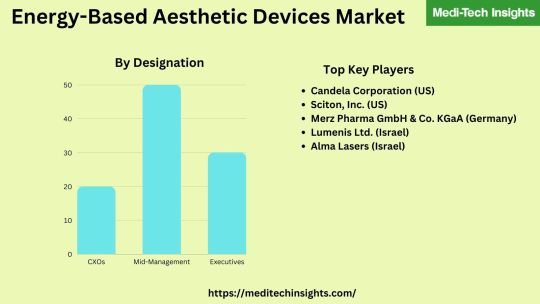
Numerous skin procedures, such as body sculpting, skin tightening, and resurfacing, utilize energy-based aesthetic devices. These devices are precise, targeted medical equipment with adjustable wavelengths that provide a range of therapeutic options. These devices are based on technologies that rejuvenate the skin, enhance texture and complexion, provide a smoother & younger look, and remove unwanted imperfections by utilizing a variety of energy sources.
The Global Energy-based Aesthetic Devices Market valued at $5 billion (2021) is set to witness a growth rate of 10% in the next 5 years. Technological improvements in aesthetic devices, endorsement of aesthetic treatments by celebrities, increased usage of social media and video-conferencing during Covid-19 pandemic leading to ‘Zoom Boom’ effect, rise in the incidence of skin disorders such as acne & fungal skin infections, and large population susceptible to various signs of aging and longer life expectancy are some of the main factors driving the global energy-based aesthetic devices market.
Technological advancements in energy-based aesthetic devices market to Fuel its Global Demand
Constant improvements in energy-based aesthetic devices have enabled the development of effective devices with expanded indications, reduced side effects, and improved patient comfort, among other things. Such advancements tend to provide competitive edge to manufacturers and thus, major players are continuously focusing on investing in research activities for the development of new products and expanding their geographic reach to strengthen their positions in the global energy-based aesthetic devices market.
Below is a list of a few technological developments:
In June 2022, Cynosure launched the PicoSure Pro device, a 755nm picosecond laser that utilizes pressure to deliver energy in one trillionth of a second instead of heat, providing safe and effective treatments for skin revitalization and unwanted pigmentation for all skin types
In March 2022, Lumenis launched the triLift facial stimulation device for three aging elements, namely, texture, contour, and structure by treating three tissue layers- epidermal layer, muscles, and dermal layer
In April 2021, Alma Laser, a Sisram Medical company launched Alma PrimeX platform, a combination of ultrasound and radiofrequency technologies, used in skin tightening and circumference reduction in the abdomen, thighs, waist, and buttocks areas
In April 2021, LASEROPTEK Co., Ltd. received 510(k) clearance from the US Food and Drug Administration (FDA) to expand the indications of its PicoLO picosecond pulse Nd:YAG laser for the treatment of acne scars, benign pigmented lesions, and wrinkles
Explore Premium Report on Energy-Based Aesthetic Devices Market @ https://meditechinsights.com/energy-based-aesthetic-devices-market/
Key strategies adopted by market players operating in Energy-based Aesthetic Devices Market
Leading players in the energy-based aesthetic devices market have accepted acquisition and partnership as key growth strategy to expand their product offerings, enhance their geographic presence & distribution capabilities, and to develop advanced products.
Some of these developments are listed below -
In August 2022, Sofwave Medical Ltd, developer of energy-based non-invasive, aesthetic medical devices entered in a collaboration and distribution agreement with HTDK Group to advance and expand its sales in China
In May 2022, Crown Laboratories entered in an agreement to acquire the global, aesthetics-focused assets of Eclipse, to expand its aesthetics' product portfolio and to provide superior aesthetic products across geographies
In March 2022, Cynosure KK (subsidiary of Cynosure LLC) and Jeisys Medical KK (subsidiary of Jeisys Medical Inc.) entered into a distribution partnership, in which Jeisys Medical will have exclusive distribution rights to Cynosure's energy-based laser portfolio's premier products in Japan
In December 2021, Allergan Aesthetics, a subsidiary of AbbVie completed the acquisition of Soliton, Inc., a medical device company offering proprietary platform technology for aesthetic solutions- RESONIC, its Rapid Acoustic Pulse device. This acquisition was aimed at expanding and complimenting Allergan’s body contouring treatment portfolio
Competitive Landscape Analysis of Energy-Based Aesthetic Devices Market
The global energy-based aesthetic devices market is marked by the presence of key players such as Candela Corporation (US); Sciton, Inc. (US); Merz Pharma GmbH & Co. KGaA (Germany); Lumenis Ltd. (Israel); Alma Lasers (Israel); Cutera (US); Allergan Plc (Ireland); Cynosure (US); and others.
For More Detailed Insights, Contact Us @ https://meditechinsights.com/contact-us/
About Medi-Tech Insights
Medi-Tech Insights is a healthcare-focused business research & insights firm. Our clients include Fortune 500 companies, blue-chip investors & hyper-growth start-ups. We have completed 100+ projects in Digital Health, Healthcare IT, Medical Technology, Medical Devices & Pharma Services.
Contact:
Ruta Halde
Associate, Medi-Tech Insights
+32 498 86 80 79
0 notes
Text
Global Mechanical Thrombectomy Devices Market was valued at US$ 760 million in 2021 and is projected to expand at a CAGR of 6% by 2026
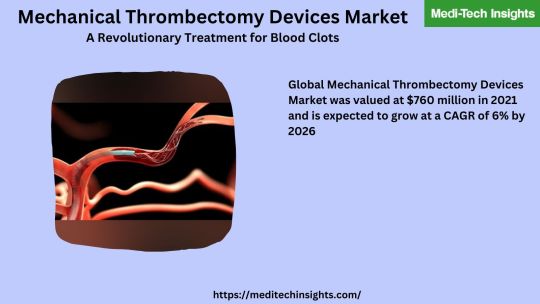
A common health concern that requires immediate medical attention is blood clots. Mechanical thrombectomy devices are used in procedures used to treat arterial blockages caused by blood clots. A mechanical thrombectomy can be used to treat ischemic stroke, pulmonary embolism (PE), and deep vein thrombosis (DVT).
The Global Mechanical Thrombectomy Devices Market was valued at US$ 760 million in 2021 and is set to witness a healthy growth rate of 6% in the next 5 years. The rising cases of stroke, venous thromboembolism (deep vein thrombosis & pulmonary embolism), approval/launch of novel mechanical thrombectomy devices, favorable clinical trial outcomes with mechanical thrombectomy, and acquisitions by leading players to fortify their vascular portfolio, and treat patients with blood clots are some of the important factors driving the global mechanical thrombectomy devices market.
However, some of the crucial factors that are likely to hamper its development are inadequate specialists and limited awareness and education of both the physicians and the patients.
Technological Advancements in Mechanical Thrombectomy Devices Drives the Mechanical Thrombectomy Devices Market
Technological advancements are expected to boost the mechanical thrombectomy devices market.
For instance,
In April 2022, Penumbra announced that its Indigo Aspiration System with Lightning 7 and Lightning 12 has secured CE Mark and are now commercially available in Europe. Both technologies are part of Penumbra’s Indigo Aspiration System - now with Intelligent Aspiration for mechanical thrombectomy -and are designed for single-session arterial and venous thrombus removal, including the treatment of pulmonary embolisms
“Existing mechanical thrombectomy treatment options do not adequately treat VTE for several reasons. Most current mechanical thrombectomy devices are designed to aspirate fresher arterial clot, which is small and soft. As a result, these devices can be inadequate and ineffective for removing the larger, older clots associated with VTE.” - General Manager, Commercial-stage Medical Device Company, APAC
Explore Premium Report on Mechanical Thrombectomy Devices Market @ https://meditechinsights.com/mechanical-thrombectomy-devices-market/
Covid-19 Impact on the Mechanical Thrombectomy Devices Market
In 2020, the number of elective procedures reduced significantly due to Covid-19 which resulted in a decline in the market. There are various plausible reasons for the apparent reduction in mechanical thrombectomy performance between 2020-2021:
Delays in accessing specialized care, resulting in patients presenting outside of the therapeutic window
Reluctance of acute ischemic stroke patients to present at emergency departments
Reduction in stroke occurrence during the COVID-19 pandemic as a result of mandated social distancing
However, towards the end of 2021 fourth quarter, companies witnessed the pressure from COVID-19 gradually alleviated and businesses are now trending close to normalized run rates.
Organic and Inorganic Growth Strategies Adopted by Players to Establish Their Foothold in Mechanical Thrombectomy Devices Market
The players operating in the mechanical thrombectomy devices market adopted both organic and inorganic growth strategies such as acquisitions and new product launches to garner market share.
For instance,
In April 2022, Wallaby Medical acquired phenox GmbH. phenox has a broad product portfolio covering both ischemic and hemorrhagic stroke as well as Access & Support. The key product lines of phenox include the p64/p48 range of flow diverters for the treatment of intracranial aneurysms and the pRESET range of stent retrievers for the mechanical thrombectomy of ischemic strokes
The outlook for the mechanical thrombectomy devices market looks promising due to the increasing geriatric population and cases of stroke, venous thromboembolism, technological developments in mechanical thrombectomy devices, strong product pipeline, established coding & payments for mechanical thrombectomy in key markets such as the U.S. and growing awareness about mechanical thrombectomy due to patient advocacy groups and clinical society support.
Competitive Landscape Analysis of Mechanical Thrombectomy Devices Market
The global mechanical thrombectomy devices market is marked by the presence of players such as Medtronic, Stryker, Penumbra, Boston Scientific, AngioDynamics, Control Medical, Inari Medical, among others.
For More Detailed Insights, Contact Us @ https://meditechinsights.com/contact-us/
About Medi-Tech Insights
Medi-Tech Insights is a healthcare-focused business research & insights firm. Our clients include Fortune 500 companies, blue-chip investors & hyper-growth start-ups. We have completed 100+ projects in Digital Health, Healthcare IT, Medical Technology, Medical Devices & Pharma Services.
Contact:
Ruta Halde
Associate, Medi-Tech Insights
+32 498 86 80 79
0 notes
Text
Global Dental Market is projected to grow at a CAGR of 6-7% % to reach ~36 billion by 2026
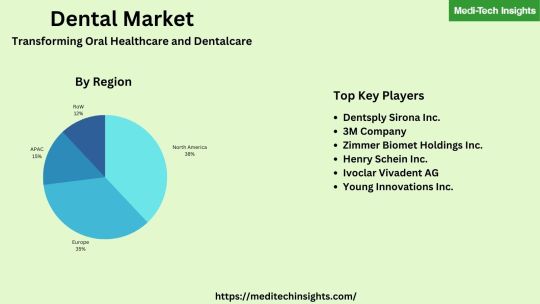
Dentistry is concerned with diagnosing, treating, and preventing a range of oral and dental conditions. Good oral health includes the ability to eat, speak, socialize, and enjoy a healthy diet and makes a major contribution to quality of life.
The Dental Market is expected to grow at a rate of 6-7% % to reach ~36 billion by 2026. Some of the main drivers propelling the global dental market are sedentary lifestyles and an ageing population that demand dental care, increased oral hygiene awareness and health consciousness, an increase in the prevalence of dental conditions including malocclusion, periodontal disease, and tooth decay, and rising demand for high-end imaging and radiology devices.
Rising Trend in the Dental Market
The goal of many of this year's dentistry trends is to improve patient care. The recent trends impacting the dental market includes:
Growing investment in the global 3D printing market
Increasing investment in laser technology
Rising demand for tele-dentistry
Growing adoption of invisible orthodontics like clear aligners
Opportunities for the Dental Market in Digital Dentistry
Every aspect of professional oral care is transforming due to digital dentistry. It encompasses any digital or computer-based technology that a dental professional may utilize to examine, diagnose, and treat the health of a mouth. Some of the technology includes: digital radiography, digital impression, intraoral cameras, and digital records, among others.
“Digital dentistry is constructively changing the conventional dental practice. Such advancements have led clinicians to deliver precise information to the patients as well as labs. The subsequent applications of these technologies will certainly change the practice of restorative dentistry.” - Business Head, Provider of Dental Health Products, U.S.
Explore Premium Report on Dental Market @ https://meditechinsights.com/dental-market/
The Advent of CAD/CAM Technology in Dental Dentistry Drives the Growth of the Global Dental Market
Digital dentistry, including CAD/CAM dentistry, is transforming every aspect of professional oral care in dentistry to date. Digital dentistry encompasses any digital or computer-based technology that the dental professional may use to examine, diagnose, and treat the health of the mouth.
For instance,
In March 2022, Anthogyr announced the launch of Axiom X3 implant system. The Axiom implant range is well-known among dental implantologists for outstanding prosthetic performance, simplicity of use, and consistency in treatment results
Growing Opportunities in Dental Tourism Fuels the Dental Market Demand
Dental tourism has become a trending industry as many patients travel around the world to receive dental treatment. The high cost of dental care services, absence of insurance coverage, and dissatisfaction with available services in home countries have motivated people to seek affordable, speedy, and better-quality dental care in foreign countries.
Key Challenges/ Constraints: Dental Market
Some of the main factors restricting the expansion of the dental market are the high costs associated with dental procedures and advanced technology-based dental devices, the limited reimbursement policies for dental implants and surgeries, and the high risk and problems associated with treatments.
North America Holds the Largest Market Share but APAC is Set to Witness Strongest Growth
North America holds a one-third share of the dental market. This may be mainly due to the rising incidence of tooth decay, technological advancements in dental care, an increase in the number of patients who are partly edentulous, and expanding dental care awareness in the region.
Companies Adopting Organic & Inorganic Growth Strategies to Increase their Market Share
Key players operating in the dental market are adopting various business strategies such as collaborations, acquisitions, partnerships, and new product launches to garner market share.
For instance,
In September 2022, Dentsply Sirona announced the launches of its new digital dentistry solutions Primescan Connect, and DS Core Care at DS World 2022 in Las Vegas
In May 2022, The Straumann Group announced they have signed an agreement to fully acquire PlusDental, a provider of orthodontic treatment solutions in Europe
Competitive Landscape Analysis of Dental Market
Some of the key players operating in the dental market include Straumann Holding, Dentsply Sirona, 3M, Henry Schein Inc., EnvisionTEC, BioHorizons, and Bicon Dental Implants, among others.
For More Detailed Insights, Contact Us @ https://meditechinsights.com/contact-us/
About Medi-Tech Insights
Medi-Tech Insights is a healthcare-focused business research & insights firm. Our clients include Fortune 500 companies, blue-chip investors & hyper-growth start-ups. We have completed 100+ projects in Digital Health, Healthcare IT, Medical Technology, Medical Devices & Pharma Services.
Contact:
Ruta Halde
Associate, Medi-Tech Insights
+32 498 86 80 79
0 notes
Text
Global Spinal Muscular Atrophy Treatment Market is anticipated to grow at a CAGR of ~13% by 2026
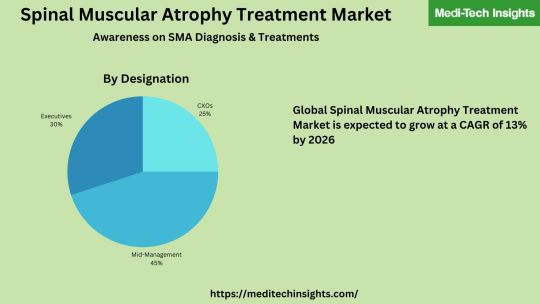
Spinal Muscular Atrophy refers to a group of hereditary diseases that damages and kills specialized nerve cells in the brain and spinal cord (called motor neurons). Motor neurons control movement in the arms, legs, face, chest, throat, and tongue, as well as skeletal muscle activity including speaking, walking, swallowing, and breathing. SMA occurs in Type 1, Type 2, Type 3, and Type 4 types.
The Global Spinal Muscular Atrophy Treatment Market is expected to grow at a rate of ~13% by 2026. Some of the main factors propelling the global spinal muscular atrophy treatment market is the rising prevalence of spinal muscular atrophy (SMA), growing awareness of SMA diagnosis and treatment, increasing number of initiatives to improve treatment options for rare diseases, and rising R&D activities to develop novel therapies & treatments for spinal muscular atrophy (SMA). However, the high cost associated with the treatment of spinal muscular atrophy (SMA) is likely to hamper the market growth.
Increasing R&D Activities for the Treatment of Spinal Muscular Atrophy Drives the Market
Currently, there is no known cure for Spinal Muscular Atrophy (SMA). However, multiple treatments are available to help slow the progression of the disease, relieve symptoms, and manage potential complications. In addition to these approved treatments, several other treatments are being tested in clinical trials.
For instance,
In January 2022, Cytokinetics announced that their collaboration with Astellas to advance the development of CK-2127107/ reldesemtiv ended in late 2021
In August 2021, Novartis announced the lift of a partial clinical trial hold and planned to initiate a new, pivotal Phase 3 study of intrathecal OAV-101 in older patients with spinal muscular atrophy
Growing Adoption of Spinal Muscular Atrophy Treatment in Babies Fuels the Spinal Muscular Atrophy Treatment Market Demand
Spinal muscular atrophy affects approximately 1 in 11,000 babies born worldwide each year and is the most common genetic cause of death in infants. Children might suffer from a variety of SMAs. They vary in the age when symptoms initially appear, the seriousness of symptoms, and how symptoms get worse. Early detection and treatment of SMA are important as studies suggest that therapy is most effective when started in the first few months of life. Depending on the symptoms, treatment options for children include targeted therapy, respiratory therapy, nutritional therapy, muscle & joint therapy, and medications. Numerous innovative drugs have recently been developed that improve or ameliorate symptoms in many children.
Explore Premium Report on Spinal Muscular Atrophy Treatment Market @ https://meditechinsights.com/spinal-muscular-atrophy-sma-treatment-market/
North America Holds the Largest Market Share in Spinal Muscular Atrophy Treatment Market
North America holds the major market share of the spinal muscular atrophy treatment market followed by Europe and the Asia Pacific. The surge in the demand for drugs for the treatment including Nusinersen, Onasemnogene & Abeparvovec, rising healthcare expenditure, favorable reimbursement policies for the treatment of rare diseases, increasing awareness regarding SMA, and a rise in the number of R&D activities for the treatment of SMA in this region are some of the key factor driving the growth of the spinal muscular atrophy treatment market.
Companies Adopt both Organic & Inorganic Growth Strategies to Increase their Market Share
Players operating in the spinal muscular atrophy treatment market are adopting organic and inorganic growth strategies such as collaborations, acquisitions, and expansions to garner market share.
For instance,
In May 2022, PTC Therapeutics Inc. announced that they have received U.S. Food and Drug Administration (FDA) approval for a label extension for Evrysdi® (risdiplam) to include infants under 2 months old with spinal muscular atrophy (SMA)
In August 2021, Cytokinetics and Cure SMA announced the renewal of their partnership to increase education, awareness, public policy, and fundraising for spinal muscular atrophy (SMA)
Competitive Landscape Analysis of Spinal Muscular Atrophy Treatment Market
The global spinal muscular atrophy treatment market is marked by the presence of established key players such as Astellas Pharma Inc., AstraZeneca PLC, Biogen Inc., and Salarius Pharmaceuticals Inc., among others.
For More Detailed Insights, Contact Us @ https://meditechinsights.com/contact-us/
About Medi-Tech Insights
Medi-Tech Insights is a healthcare-focused business research & insights firm. Our clients include Fortune 500 companies, blue-chip investors & hyper-growth start-ups. We have completed 100+ projects in Digital Health, Healthcare IT, Medical Technology, Medical Devices & Pharma Services.
Contact:
Ruta Halde
Associate, Medi-Tech Insights
+32 498 86 80 79
0 notes
Text
Global Nutraceuticals Market Focuses On Top Manufacturers - Amway, Bayer, Danone, Pfizer
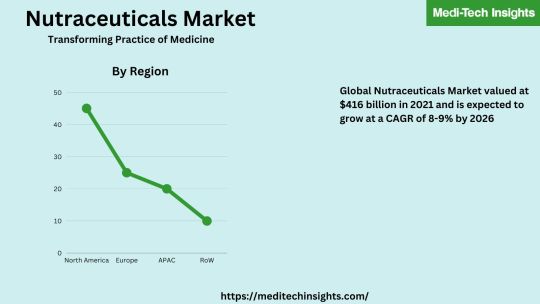
A food or part of a food that offers additional medical and health benefits, including the prevention and treatment of disease, is referred to as a nutraceutical. It can be broadly categorized into dietary supplements and functional foods & beverages.
The Global Nutraceuticals Market valued at US$ 416 billion (2021) is expected to witness a growth rate of 8-9% in the next five years. Some of the main factors propelling the global nutraceuticals market include sedentary lifestyle and an ageing population, health consciousness and awareness lead the need for dietary and food supplements, venturing of pharmaceutical & food companies into the market, growing applications of functional foods & beverages, rising affluence, and growing spending on health-related products.
However, some of the major challenge that are anticipated to hamper the market's growth include the threat of counterfeit dietary supplements and consumer distrust as a result of deceptive advertising and communication.
Nutraceuticals – Creating opportunities for Pharmaceutical & Food Companies to Diversify
The pharmaceutical companies consider ‘Nutrition’ as a profitable opportunity where they can leverage their existing strengths to establish their foothold in the market. The pharmaceutical companies possess extensive research capabilities, experience in clinical trials, have close established relationships with medical practitioners to help drive uptake, and have access to scientific databases & capabilities to create complementing nutrition solutions cantered around their existing drugs that can enhance medical outcomes in the patient pool.
Citing the lucrative prospects of the nutraceuticals market, several key pharmaceutical companies such as Pfizer, Bayer, Otsuka Pharmaceutical, and Abbott, among others have entered the market.
The potential for nutraceuticals in their portfolios has also been recognized by food and FMCG companies like Nestlé, Danone, and Amway. They are progressively leveraging their expertise in nutrition science, taste, flavoring & variable formats, packaging in short periods, market research, consumer marketing & advertising, branding, and strong relationships with retailers and distributors to establish their foothold in the market.
“The paradigm shift in healthcare from treatment to prevention is providing momentum to the nutraceuticals market. The transition has urged patients and clients to think differently about health and disease, which has created opportunities for pharmaceutical and food companies to get involved in the disease/care pathway.” - Chair of Infectious Diseases, Public Research University, London, UK
Explore Premium Report on Nutraceuticals Market @ https://meditechinsights.com/global-nutraceuticals-market/
Covid-19 Impact on Global Nutraceuticals Market
The demand for vitamins and supplements increased significantly as a result of the news that vitamin D supplementation may reduce the risk of COVID-19 complications. Research studies also suggested Vitamin D as a potent immune-modifying micronutrient and advocated supplementation and called on governments to increase the recommended levels. As a result, the nutraceuticals market was amplified and the need for vitamins, minerals, and herbal supplements increased.
The demand for dietary supplements and functional food and beverages continues to rise as a preventive measure against Covid-19 due to consumers’ inclination toward better health and wellbeing. The demand for nutraceuticals is anticipated to continue for a longer period of time due to rising awareness about chronic diseases, health & preventive measures, the role of immunity, and dietary supplements.
Nutraceuticals - Potential Revenue Hot Spots
Nutraceutical manufacturers are constantly focusing to introduce products that can improve cognitive function, gluten & lactose-free products, products that can lower cholesterol & support a healthy heart, and products that can serve as a sugar substitute for diabetics in order to address the growing burden of dementia, neurodegenerative brain diseases like Alzheimer's, gut health issues, cardiovascular disease (CVD), and diabetes. A rich pipeline of such products is likely to fuel the global nutraceuticals market.
Product Innovations Drive the Market
The nutraceuticals market is dominated by technological advancements and innovative products.
For instance,
In April 2022, PharmaLinea announced its next-generation products for 2022, which includes the launch of a range for gut health, >Your< Prebiotiq Line, as well as additions to its >Your< Iron Forte Orosticks, >Your< Iron Forte Liquid Sticks and >Your< UTI Free Orosticks lines
Organic and Inorganic Growth Strategies Adopted by Players to Establish Their Foothold
The nutraceuticals market is marked by the presence of both established and new players. Players operating in the market adopt both organic and inorganic growth strategies such as acquisitions, and new product launches to garner market share.
For instance,
In June 2022, Pharmactive Biotech Products announced a new strategic partnership with Singapore-based Nutraconnect Pte, Ltd. to bring innovative, scientifically-backed nutraceutical ingredients to the Asia-Pacific marketplace
Future Outlook of Nutraceuticals Market
The nutraceuticals market is anticipated to gain further momentum in the coming years as a significant proportion of the global population is Vitamin D deficient, increasing awareness about Vitamin D benefits in bone & joint health, lifestyle disorders management & general health, venturing of pharmaceutical & food companies in the nutraceuticals market, the increasing role of consulting online medicine portals and websites of international organizations in raising awareness about the health benefits of nutraceuticals and increasing participation of athletes at national and international sports events.
Competitive Landscape Analysis of Nutraceuticals Market
The nutraceuticals market is marked by the presence of players such as Archer Daniels Midland Company, Herbalife Nutrition, Amway, Nestlé Health Science, Danone, Pfizer, Bayer, Universal NutriScience, and Innophos, and AOR Canada, among others.
For More Detailed Insights, Contact Us @ https://meditechinsights.com/contact-us/
About Medi-Tech Insights
Medi-Tech Insights is a healthcare-focused business research & insights firm. Our clients include Fortune 500 companies, blue-chip investors & hyper-growth start-ups. We have completed 100+ projects in Digital Health, Healthcare IT, Medical Technology, Medical Devices & Pharma Services.
Contact:
Ruta Halde
Associate, Medi-Tech Insights
+32 498 86 80 79
0 notes
Text
Global Electrophysiology Market Growth By Top Leading Players | Abbott Laboratories (US); Medtronic plc (Ireland); Boston Scientific Corporation (US)

Electrophysiology (EP) is a test used to diagnose abnormal heart rhythm or arrhythmias. It helps in evaluating the electrical activity of the heart by inserting a catheter into blood vessels that enter heart and then measuring the electrical activity through wire electrodes. EP ablation catheters, EP laboratory devices, EP diagnostic catheters, and EP access devices are just a few examples of the various types of EP products.
The Global Electrophysiology Market valued at $6.7 billion (2021) is set to witness a growth rate of 12% in the next 5 years. The global electrophysiology market is being driven by a number of key factors, including an increase in the volume of cardiac ablation procedures, a quick increase in the geriatric population to target diseases, a growing number of electrophysiology labs, the development of technologically advanced products by market players, and huge investments and funding from government bodies and market players.
New product development and commercialization to fuel the Electrophysiology Market demand
Technological advancements in terms of new product development tend to provide competitive edge to manufacturers and therefore, major players are continuously focusing on investing in research activities for new product development and increasing their geographic reach to strengthen their positions in this high growth market.
Below is a list of some recent developments:
In May 2022, CathVision received the US Food and Drug Administration (FDA) clearance for its ECGenius electrophysiology recording system offering high-fidelity, low-noise, cardiac electrograms, which helps electrophysiologists improve diagnosis and treatment of complex atrial arrhythmias such as atrial fibrillation (AF)
In February 2022, Medtronic received the US FDA expanded approval for its Freezor and Freezor Xtra Cardiac Cryoablation Focal Catheters for the treatment of pediatric atrioventricular nodal reentrant tachycardia (AVNRT)
In January 2022, Abbott received the US FDA clearance for its EnSite X EP System featuring EnSite Omnipolar Technology (OT), designed for the treatment of cardiac arrhythmias efficiently by creating three-dimensional maps of the heart
In June 2021, Siemens Healthineers received CE mark for its ACUSON AcuNav Volume ICE Catheter that helps in improving procedural efficiency for structural heart procedures due to reduction of general anesthesia
Explore Premium Report on Electrophysiology Market @ https://meditechinsights.com/electrophysiology-market/
Growing number of electrophysiology labs to boost adoption the Adoption of Electrophysiology Market
Increasing prevalence of atrial fibrillation and other target diseases drives the adoption of electrophysiology procedures across the globe. Both public and private organisations are continuously concentrating on creating EP labs and growing their services to provide patients with advanced treatment options.
In February 2022, Ramesh Hospitals (India) launched an advanced cardiac electrophysiology lab in Vijayawada, India with an aim to help and treat patients through advanced therapies such as RF ablation
In February 2022, Catholic Health (US) launched St. Francis Heart Center (SFHC) at its St. Catherine of Siena Hospital (SCSH) in Smithtown, US, for the treatment of patients with acute chest pain
In January 2022, Pulse Heart Institute (US) partnered with Summit Health Oregon (SHO), one of the largest independent multispecialty and physician-led medical group in Central Oregon, to launch EP services through the Heart Rhythm COE
Key strategies adopted by leading players operating in Electrophysiology Market
Leading players in the electrophysiology market have accepted acquisitions as key growth strategy to expand their product offerings and to develop advanced products.
Some of these advances are listed below-
In January 2022, Medtronic plc entered into an agreement to acquire Affera, Inc. offering solutions for cardiac arrhythmias. With this acquisition, Medtronic intends to advance its electrophysiology by entering into additional EP segments, such as mapping and navigation
In January 2022, H-CYTE, Inc. entered into a letter of intent to acquire Catheter Precision, Inc., a company focussed on developing advanced cardiac electrophysiology products
In June 2021, Boston Scientific Corporation exercised its option and acquired remaining shares of Farapulse, Inc., to complement its existing EP portfolio by including FARAPULSE Pulsed Field Ablation (PFA) System
In January 2021, Haemonetics Corporation entered into an agreement to acquire Cardiva Medical, Inc., a manufacturer of vascular closure system used during electrophysiology procedures
Competitive Landscape Analysis of Electrophysiology Market
The global electrophysiology market is marked by the presence of key players such as Abbott Laboratories (US); Medtronic plc (Ireland); Boston Scientific Corporation (US); BIOTRONIK SE & Co. KG (Germany); Johnson & Johnson (US); and others.
For More Detailed Insights, Contact Us @ https://meditechinsights.com/contact-us/
About Medi-Tech Insights
Medi-Tech Insights is a healthcare-focused business research & insights firm. Our clients include Fortune 500 companies, blue-chip investors & hyper-growth start-ups. We have completed 100+ projects in Digital Health, Healthcare IT, Medical Technology, Medical Devices & Pharma Services.
Contact:
Ruta Halde
Associate, Medi-Tech Insights
+32 498 86 80 79
1 note
·
View note
Text
Global Psoriasis Treatment Market is anticipated to grow at a CAGR of ~8.5% by 2026
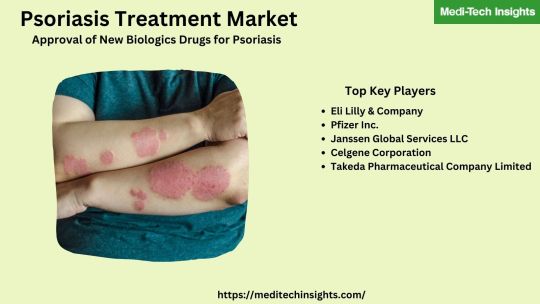
Psoriasis is a complex, chronic, multifactorial, inflammatory disease that involves hyperproliferation of the keratinocytes in the epidermis, with an increase in the epidermal cell turnover rate. Currently, topical, systemic therapies, and phototherapy are available for treatment.
The Global Psoriasis Treatment Market is expected to grow at a rate of ~8.5% by 2026. Increasing psoriasis prevalence, rising psoriasis medicines demand in emerging economies, rising biologic drug approval for psoriasis treatment, increased psoriasis research activity, a strong drug pipeline, and rising use of combination therapies for psoriasis treatment are some of the key factors driving the global psoriasis treatment market.
Growing Adoption of New Biologics Drugs for the Treatment of Plaque Psoriasis Drives the Psoriasis Treatment Market
Biologics drugs launched a new era of psoriasis treatment. These drugs target a particular part of the immune system and are created from substances found in living things. Recently, several biological drugs have been approved by the FDA to treat plaque psoriasis.
For instance,
In May 2022, Dermavant Sciences received US FDA approval for VTAMA (tapinarof) cream, 1%, an aryl hydrocarbon receptor agonist, indicated for the topical treatment of plaque psoriasis in adults.
Increase in Usage of Interleukins (IL) Inhibitors in Psoriasis Treatment Fuels the Demand
The preference for IL inhibitors over other classes of psoriasis drugs includes several factors such as improved safety and efficacy, more targeted mechanism of action, fewer warnings & side effects, faster onset of effect, and more durable responses. Recently, the FDA approved a number of drugs for treatment purposes.
For instance,
In January 2022, AbbVie received US FDA approval for SKYRIZI® (risankizumab-rzaa) for the treatment of adults with active psoriatic arthritis (PsA).
Explore Premium Report on Psoriasis Treatment Market @ https://meditechinsights.com/psoriasis-treatment-market/
Growing Usage of Combination Therapies for Psoriasis Treatment Boost the Psoriasis Treatment Market
The most common method of treating psoriasis is combination therapy. It involves the combination of two drugs to achieve improved therapeutic results for patients who inadequately respond to a single drug. Moreover, combination therapy may reduce safety concerns and cumulative toxicity, as a lower dose of two single agents may offer a better safety and efficacy profile when used in combination. The wide range of combination therapies prescribed may reflect increased attention to individualization of treatment to match patients’ diverse preferences.
Key Constraints/ Challenges: Psoriasis Treatment Market
Psoriasis treatments can be expensive, life - long, and sometimes not covered by universal health coverage schemes. Some of the major factors that are anticipated to hamper the psoriasis treatments market in the upcoming years include a lack of standardized tools for diagnosis and treatment, stringent regulatory policies, and negative side effects associated to the existing medications.
North America Expected to Continue to Hold a Major Share in the Psoriasis Treatment Market
Geographically speaking, North America holds a major market share of the psoriasis treatment market. This can be mainly attributed to the expanding incidence of plaque psoriasis & psoriatic arthritis, the increasing prescription volume of biological products, and growing awareness regarding the diagnosis and treatment of psoriasis in the region.
Increasing Emphasis on Developing New Biological Products
Players operating in the psoriasis treatments market are adopting organic and inorganic growth strategies such as collaborations, acquisitions, and new product launches to garner market share.
For instance,
In July 2022, Arcutis Biotherapeutics, Inc. received FDA approval for the new drug application (NDA) for ZORYVE (roflumilast) cream 0.3% for the treatment of plaque psoriasis, including intertriginous areas, in patients 12 years of age or older
In December 2021, AbbVie received FDA approval for RINVOQ® for the treatment of adults with active psoriatic arthritis (PsA)
Competitive Landscape Analysis of Psoriasis Treatment Market
Some of the key players operating in the global psoriasis treatment market include Eli Lilly & Company, Pfizer Inc., Novartis International AG, Amgen Inc., Biogen Inc., Abbvie Inc., AstraZeneca, among others.
For More Detailed Insights, Contact Us @ https://meditechinsights.com/contact-us/
About Medi-Tech Insights
Medi-Tech Insights is a healthcare-focused business research & insights firm. Our clients include Fortune 500 companies, blue-chip investors & hyper-growth start-ups. We have completed 100+ projects in Digital Health, Healthcare IT, Medical Technology, Medical Devices & Pharma Services.
Contact:
Ruta Halde
Associate, Medi-Tech Insights
+32 498 86 80 79
0 notes
Text
Global Albumin Market is expected to grow at a healthy CAGR of ~6% by 2026

Albumin is the most abundant circulating protein in the plasma, accounting for more than half of the human plasma protein. Albumin has been usually studied as a protein carrier for drug delivery. They are utilized in a various applications including oncology, diabetes, hepatitis C, hypovolemia, and rheumatoid arthritis.
The Global Albumin Market is expected to grow at a rate of ~6% by 2026. The development of albumin-based nanoparticles for drug delivery, high demand for albumin in R&D activities & clinical trials, rising production of immunoglobulin, growing plasma collection, increased preference for recombinant albumin in drug delivery, increasing awareness about the benefits of albumin, growing usage of albumin as blood volumizer in a condition of shocks & burns, and rise in non-therapeutic applications of albumin as a multifunctional excipient are some of the key factors driving the global albumin market.
Growing Demand for Albumin in Research & Development and Clinical Trials Drives the Global Albumin Market
Malignant, inflammatory, metabolic, and viral diseases are specifically treated and diagnosed with albumin-based therapeutic agents. Considering the commercial success of products that utilise albumin as a drug carrier and the ongoing clinical trials albumin is attracting the interest of researchers, pharmaceutical, and biotechnological companies.
Albumin-Based Nanoparticles Offer Promising Drug Delivery System for Cancer Treatment
Albumin is a versatile biomaterial for the synthesis of nanoparticles. The efficiency of the albumin-based delivery resides in its capacity to improve tumor targeting and accumulation. Additionally, albumin can bind to special receptors overexpressed on cancer cells and enhance nanoparticle binding and internalization.
Explore Premium Report on Albumin Market @ https://meditechinsights.com/global-albumin-market/
Growing Adoption of Recombinant Albumin over Serum-based Albumin for Drug Delivery Fuels the Albumin Market Demand
As regulatory guidelines have driven the need for animal-free options, there has been a decline in the use of serum-derived albumin. Historical risks related to human serum albumin have been eliminated with the availability of recombinant albumin. It also provides a relatively simple solution to traditional formulation strategies and provides a cost-effective, single solution to several stability issues.
The Potential Role of Human Serum Albumin in Covid-19 Patients Boosts the Albumin Market
Albumin downregulates the expression of the ACE2 receptors and has been shown to improve the ratio of arterial partial pressure of oxygen/fraction of inspired oxygen in patients with acute respiratory distress syndrome as soon as 24 hours after treatment and with an effect that persists for at least seven days. Furthermore, researchers who have studied the clinical characteristics of Covid-19 patients have reported that low serum albumin on presentation in COVID-19 infection is associated with a higher incidence of serious outcomes like kidney injury, cardiac injury, and higher mortality, among others.
Key Challenges/ Constraints: Albumin Market
The stringent government regulations, limited reimbursement, rising shift towards serum-free solutions, and side effects associated with the use of albumin are the major factors restraining the growth of the albumin market.
North America Holds the Largest Market Share but APAC is Set to Witness Strongest Growth
The biggest market share for albumin market is held by North America. This can be mainly attributed to the increasing demand for albumin-based R&D activities, the presence of advanced and robust healthcare infrastructure, the rising demand for albumin in various non-therapeutics applications, and the presence of market key players in the region.
Companies Adopt both Organic & Inorganic Growth Strategies to Increase their Market Share
To gain market share, players in the albumin market are adopting both organic and inorganic growth strategies, such as collaborations, acquisitions, and expansions.
For instance,
In April 2022, Apotex Corp. announced the release of its Paclitaxel protein-bound particles for injection (albumin-bound), a generic version of Abraxane in the United States
In January 2022, Bio Products Laboratory (BPL), announced that the National Medical Products Administration (NMPA) for China has granted BPL a license to market ALBUMINEX® 25% product to China
Competitive Landscape Analysis of Albumin Market
The global albumin market is marked by the presence of established key players such as Baxter International Inc., China Biologic Products Inc, Grifols S.A., Apotex Corp., and InVitria, among others.
For More Detailed Insights, Contact Us @ https://meditechinsights.com/contact-us/
About Medi-Tech Insights
Medi-Tech Insights is a healthcare-focused business research & insights firm. Our clients include Fortune 500 companies, blue-chip investors & hyper-growth start-ups. We have completed 100+ projects in Digital Health, Healthcare IT, Medical Technology, Medical Devices & Pharma Services.
Contact:
Ruta Halde
Associate, Medi-Tech Insights
+32 498 86 80 79
0 notes
Text
Global Heparin Market is projected to expand at a CAGR of ~5% by 2026

Heparin is an injectable anticoagulant prescription medicine used to treat and prevent the symptoms of blood clots caused by medical conditions or medical procedures. Additionally, it is utilized to make an anti-clotting surface inside a variety of medical devices, including test tubes and renal dialysis machines.
The Global Heparin Market is expected to grow at a rate of ~5% by 2026. The rising prevalence of chronic diseases such as venous thromboembolism, pulmonary embolism, renal diseases, and cardiovascular disorders, increasing geriatric population, high demand for anticoagulants, growing application of heparin in various surgeries such as orthopedic and heart surgeries, and the expanding availability of synthetic and semi-synthetic heparin mimetics that help in the treatment of cancer, coagulation, and inflammatory diseases are a few of the main factors driving the global heparin market.
Increasing Usage of Heparin in Various Applications Drives the Heparin Market
Anticoagulants work by decreasing the clotting ability of the blood. It helps to prevent the formation of clots as well as stop the further expansion of any existing clots. As a result, it may be used in a variety of applications, including:
Prevent or treat certain blood vessel, heart, and lung conditions
Prevent blood clotting during open-heart surgery, bypass surgery, kidney dialysis, and blood transfusions
Prevention of deep vein thrombosis
Prevention of a blood clot following percutaneous coronary intervention
Growing Adoption of Low Molecular Weight Unfractionated Heparin Over Heparin to Prevent Deep Vein Thrombosis or Pulmonary Embolism Fuels the Demand
Low-molecular-weight heparins have several advantages over UFH that have led to their increasing use for several thromboembolic indications such as deep vein thrombosis (DVT) and pulmonary embolism (PE) as well as atrial fibrillation (AF). In comparison to heparin, LMWH provides better bioavailability and a longer half-life, streamlined dose, predictable anticoagulant response, a reduced risk of heparin-induced thrombocytopenia (HIT), and a reduced risk of osteoporosis.
Explore Premium Report on Heparin Market @ https://meditechinsights.com/global-heparin-market/
The Potential Role of Heparin in Covid-19 Patients Boosts the Heparin Market Growth
Many patients with COVID-19 develop a clinically significant coagulopathy. COVID-19 infections can lead to an increased risk of blood clots. These blood clots can lead to individuals being admitted to hospital, or, unfortunately in severe cases, death. Similarly, patients with COVID-19 are at high risk for developing clinically significant large-vessel thrombosis. Thus, early usage of anticoagulation may reduce the risk of coagulopathy, microthrombus formation, and organ damage.
Key Challenges/ Constraints: Heparin Market
The main factors limiting the market's growth are the side effects associated to the usage of heparin drugs and the availability of another anticoagulant on the market.
North America Holds the Largest Market Share but APAC is Set to Witness Strongest Growth
North America holds the largest market share of the heparin market followed by Europe and the Asia Pacific. This can be primarily attributed to the high burden of chronic diseases, the presence of advanced and robust healthcare infrastructure, increasing demand for heparin in various surgeries, and rising incidences of cardiovascular disorders in the region.
Companies Adopt both Organic & Inorganic Growth Strategies to Increase their Market Share
Players operating in the heparin market are adopting organic and inorganic growth strategies such as collaborations, acquisitions, and expansions to garner market share.
For instance,
In February 2022, Techdow USA Inc. announced the launch of its Heparin Sodium Injection, USP in the United States market
In January 2022, Ohio-based biotechnology company Optimvia Pharmaceuticals announced the development of a synthetic method for creating large quantities of heparin, which is used to make a common blood thinner at a reasonable price
Competitive Landscape Analysis of Heparin Market
The global heparin market is marked by the presence of established key players such as Baxter International Inc., B. Braun Holding GmbH & Co. KG, Dr. Reddy’s Laboratories Ltd., and Fresenius SE & Co KGaA among others.
For More Detailed Insights, Contact Us @ https://meditechinsights.com/contact-us/
About Medi-Tech Insights
Medi-Tech Insights is a healthcare-focused business research & insights firm. Our clients include Fortune 500 companies, blue-chip investors & hyper-growth start-ups. We have completed 100+ projects in Digital Health, Healthcare IT, Medical Technology, Medical Devices & Pharma Services.
Contact:
Ruta Halde
Associate, Medi-Tech Insights
+32 498 86 80 79
0 notes
Text
Global Brain Monitoring Market is anticipated to raise at a CAGR of ~6-7% by 2026
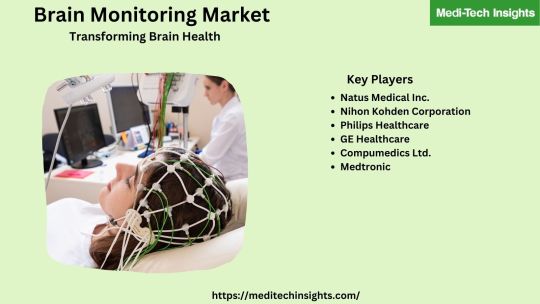
Clinical neurological, neurophysiological, neuroradiological, ultrasound-based, and invasive monitoring of a patient's nervous system is referred to as brain monitoring. The aim of brain monitoring is to identify altered or pathological neurological function as soon as possible so that the appropriate treatment can be administered before irreversible harm occurs.
The Brain Monitoring Market is expected to grow at a rate of ~6-7% by 2026. Some of the major factors propelling the global brain monitoring market include the rising prevalence of neurological disorders, technological developments in brain monitoring devices, increased prevalence of traumatic brain injuries, rising demand for non-invasive and minimally invasive devices, increased use of brain monitoring in clinical trials, and expanding therapeutic applications of brain monitoring devices.
Growing Demand for Non-Invasive Brain Monitoring Techniques for Measuring Intracranial Pressure Drives the Market
Non-invasive monitoring methods provide a reliable alternative to invasive methods. ICP monitors, transcranial doppler, electroencephalogram, near-infrared spectroscopy, and other techniques are available and can be utilized in a variety of situations. Citing the growing demand for non-invasive techniques, several players have launched innovative products which are expected to propel the market in the coming years.
For instance,
In September 2021, NeuroWave Systems Inc. announced the FDA clearance of its NeuroSENSE® NS-901 Monitor
In August 2020, IRRAS AB announced the first patient treatment using the Hummingbird Solo
Increase in Usage of Electroencephalogram (EEG) for Diagnosing Neurological Disorder Propels the Brain Monitoring Market
An EEG is a test that detects abnormalities in brain waves or the brain’s electrical activity. The EEG is utilized to evaluate several types of brain disorders such as monitoring blood flow in the brain during surgical procedures determining the overall electrical activity of the brain, Alzheimer’s disease, certain psychosis, and a sleep disorder called narcolepsy, epilepsy, etc.
Explore Premium Report on Brain Monitoring Market @ https://meditechinsights.com/global-brain-monitoring-market/
Potential of Brain Monitoring Using Sensors, Wearables, and Mobile Devices Boost the Market
Rapid technological advances have been witnessed in the area of portable EEG monitoring, sleep assessment, gait analysis, cognitive function testing, eye tracking, and voice analysis.
For instance:
Interaxon Inc. launched the second generation of its popular EEG meditation & sleep headband, Muse S
NeuroSky developed ZenZone’s apps designed to receive feedback data from the body via a sensor, which helps the app understand the state of mind and body
Growing Adoption of Brain Multimodality Monitoring in Neurocritical Care of Comatose Patients Fuels the Demand
Neurocritical care patients are at risk of developing secondary brain injury. Multimodality monitoring (MMM) involves the use of a variety of tools to monitor changes in brain metabolism, perfusion, and oxygenation in order to modify therapy before irreversible injury occurs.
Key Constraints/ Challenges: Brain Monitoring Market
Some of the major factors that are anticipated to hamper the growth of the brain monitoring market are high costs associated with the complex brain monitoring procedures and devices, unfavorable reimbursement policies, and a shortage of trained professionals.
North America Holds the Largest Share in the Global Brain Monitoring Market
North America currently holds a major share in the global brain monitoring market. This can be mainly attributed to the growing adoption of technologically advanced brain monitoring devices, rising awareness regarding neurodegenerative disorders, and increasing applications in clinical trials in the region.
Organic and Inorganic Growth Strategies Adopted by Players to Establish Their Foothold in the Brain Monitoring Market
Players operating in the brain monitoring market are implementing organic and inorganic growth strategies such as collaborations, acquisitions, and new product launches to garner market share.
For instance,
In July 2022, Philips announced that they have received U.S. Food and Drug Administration (FDA) 510(k) clearance for their SmartSpeed artificial intelligence (AI) powered MR acceleration software
In October 2021, Brain Scientific announced that they have received FDA Clearance for Next-Gen NeuroCap EEG Headset, an advanced Electroencephalogram (EEG) electrode array
Competitive Landscape Analysis of Brain Monitoring Market
Some of the key players operating in the global brain monitoring market include Natus Medical Inc., Nihon Kohden Corporation, Philips Healthcare, and Siemens Healthineers, among others.
For More Detailed Insights, Contact Us @ https://meditechinsights.com/contact-us/
About Medi-Tech Insights
Medi-Tech Insights is a healthcare-focused business research & insights firm. Our clients include Fortune 500 companies, blue-chip investors & hyper-growth start-ups. We have completed 100+ projects in Digital Health, Healthcare IT, Medical Technology, Medical Devices & Pharma Services.
Contact:
Ruta Halde
Associate, Medi-Tech Insights
+32 498 86 80 79
0 notes